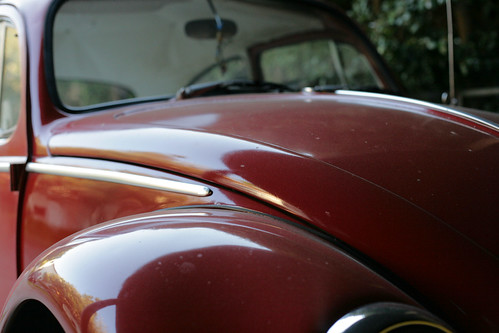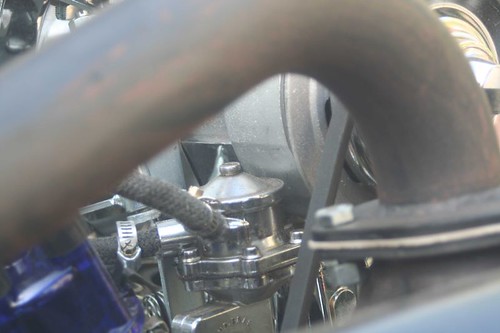
Once again, my ’65 VW Beetle has developed a problem.
I’ve been having some sewer pipe work done at my house which has made the driveway inaccessible. I needed to move a car out of the driveway just in case I needed one. With three cars to choose from, I figured that the ’65 Beetle with its locking engine compartment would be the hardest to steal. I moved it out into the neighbor’s driveway where it was only occasionally blocked by all the construction equipment. I used it a couple of times during the week and it ran and drove just fine.
On Friday, my neighbor needed to get his own car out of his driveway, so I moved the Beetle out onto the street. We live on a rather steep hill. Since the gas tank was full, I parked the car nose uphill in the morning so the gas wouldn’t leak out of the tank. In the afternoon of that same day, I went out to start it up and head off to a meeting. I turned the key in the ignition and only got a “click.” I thought, “Okay, the battery has gone dead. I’ll deal with that after I get back home.” I fired up the dune buggy and backed out of the driveway over the top of the wooden and metal covers on the three holes where the repair guys had been working earlier in the day. That was fine and I made it to my appointment only a few minutes late.
When I returned home, I went out to Beetle to see if I could figure out exactly what was wrong with it. When I tried to start it, I still only got this “click.” It sounded very similar to the sound I’d heard before when the battery didn’t have enough charge left to turn the starter. It wasn’t exactly the same sound though and the dashboard lights didn’t really indicate to me that the battery was dead. Still, I gave it the benefit of the doubt and took the battery out and put in on the charger in the basement.
A few hours later, the battery was showing that it now had a fair amount of charge available. Certainly enough to get the car started so that I could move it off the street. I put the battery back into the car and hooked it up. Still just a “click.” Okay, maybe something is locked up and I can bump the engine by popping the clutch with the transaxle in reverse and get it turning. I let it roll back a bit and engaged the clutch. Wham! A dead stop. I tried it again. Same result. Okay, the engine won’t turn over at all. The problem was now increased in magnitude from the simple dead battery to a possible seized engine. I still need to get it off of the street, though I was beginning to be less concerned about someone stealing it. In fact, I had momentary thoughts of encouraging someone to take it away and put me out of its misery. Instead, I let it roll down the hill and got it partly into the driveway. With our driveway, first you have to go up the driveway before you can go down. With the help of some very kind passers-by, we got it into the driveway and down to where it wasn’t going to be in the way. I left it there for the night.
The next morning, when I went out to see what was wrong, I had the benefit of several hours of pushing all the evidence around in my mind. As I approached the car I could smell a strong odor of raw gasoline. With the fact that it had started and run just fine when I backed it out onto the street and parked it; and the fact that the starter couldn’t make the engine turn; plus the fact that bumping the engine by popping the clutch hadn’t worked; I suspected that the engine was filled with gasoline – all of the engine including the manifold, the cylinders and the crankcase. I opened up the engine compartment and, indeed, there was gasoline dripping out of the bottom of the carburetor. It was full of gasoline all the way up the bottom of the carburetor. I didn’t have time to do anything about it at that point so I just moved it farther down the driveway where it would sit more level and left it there.
Today, after the car sat for a day in a level spot, there was no more gasoline dripping out of the bottom of the carburetor. So, on the level, there was no more fuel running into the engine. I pulled the oil dipstick. The crankcase was full to the top. I grabbed a drain pan from the basement, put it under the car, loosened the drain plug and watched the result. First, the nice clean, thick oil drained into the pan, it was immediately followed by about a half a gallon of gasoline. My diagnosis was confirmed. While I let the gasoline drain out of the crankcase, I removed the spark plugs. They were all soaked in fuel. I turned on the ignition switch to activate the electric fuel pump and peered into carburetor. Gas was entering the carburetor and the float valve inside was not shutting off the flow when the float chamber was full. In a nose-up position, gravity was causing the fuel to continually run into the engine. Problem identified.
I’m left the spark plugs out and the crankcase drain plug out so the engine will dry out a bit before I go any further. The next step will be repairing the carburetor, putting new oil in the engine, putting the spark plugs back in and starting the engine. At that point I’ll probably be able to tell if there is any other damage. I’m hoping that there are not bent piston rods or valve stems. I did rotate the engine by hand and it seems okay. I’ll have to wait a couple of days for the parts stores to open before I can get parts and continue the repair before I’ll know for sure. I wouldn’t be at all surprised if the engine has severe damage. That would be just typical of how things have gone ever since I bought this car.
I’m beginning to believe that this car is cursed. Maybe I need an exorcist.








